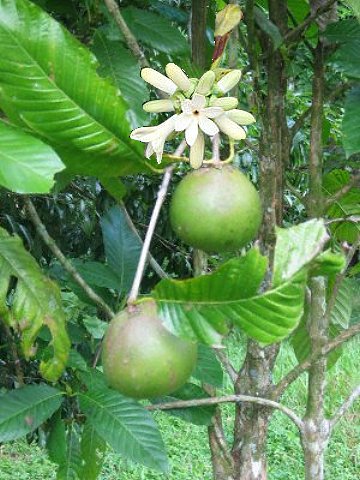
|
|
Borojo (Alibertia patinoi - Borojoa
patinoi). Flowers and fruits
|
Borojo - Alibertia patinoi - Borojoa patinoi
Alibertia patinoi (Borojoa patinoi) commonly known as
borojo, is a small (2-5m), dioecious tropical rainforest tree. It is one of the few of the Rubiaceae family that has edible
fruit. Endemically a wild plant native to the west and south basins of the Amazon
river, in the zone shared by Peru, Brazil and Bolivia. Borojo patinoi is found in the region of
Collided, on the peaceful coast of Colombia. It is also found in the Darien
jungle, at the border between Panama and Colombia. It grows also in the northwest area of Colombia in the Choco Department and in the Esmeraldas Province of
Ecuador, in areas of high humidity and temperature.
Borojo is an Embera word
meaning: boro = head, jo = fruit - head-shaped fruit, or round, globulous fruit.
The Borojo tree is found wild and also cultivated commercially
(an estimated 3000 ha under cultivation), and it is marketed locally in Western
Colombia.
The Borojoa patinoi is a shrub of 3 to 5 meters in height. Straight stalk, decussate
leaves, with well defined stipule, coriaceous.The tree has grey-brown bark and sometimes has two or three smaller trunks as well as one main
one. It needs high humidity (over 85%) and temperature (an average of at least 25°C) to
thrive, though it can tolerate brief frosts as well as floods. The Borojo tree needs a lot of
shade, and usually grows in the shade of other trees. Borojo is dioecious (separate male and female
plants). Male Borojo plants have clusters of fragrant white flowers. Females have a single white flower at the tips of
branches. Only the female plants produce fruits.
Masculine flowers in chapters, short calyx, prismatic or conic, generally
actinomorphous, sessile, pentamerous and some times tetramerous without an ovary
or, if it exists, it is rudimentary or non functional. The feminine flowers are lonely and terminal with two pairs of bracteal stipules and six longer
stigmas; inferior ovary, with umbilical calyx at the base, six cavities and many
ovules, corolla with six to nine petals, lineal stamen, empty or sterile.
The fruit is large (about 12 cm length), with a round shape, green in color at the beginning and light brown at
maturity and average weight of 740-1000 grams. The pulp represents 88% of the total
weight. The pulp constituted by mesocarp and the endocarp, with no apparent separation from the
shell, weight between 90 and 640 gr. Each fruit has 90 to 640 seeds.
The borojo fruit is harvested in rather primitive
conditions. As this fruit grows in very rich soil, on river banks in the jungles of the province of
Darien, it would be quite difficult to use other means but the horse back to harvest this rare
fruit. The fruit cannot be harvested green. At maturity the fruit turns
brown, and falls on the ground. Only then the fruit can be harvested, and only
then, the fruit has all the legendary properties it is known for. no trees are ever cut down or
destroyed. Once harvested, these fruits are transported on boats on the rivers of
Darien, to the Pacific, where they are loaded on a ship which then comes to Panama
City.
Borojo has a delicious, sweet-tart flavor – like a plum with hints of
vanilla. Natives use the pulp to prepare juice, compotes, marmalades, candies, wine or are eaten straight up as food supplement while journeying through the
jungles. In Colombia, the borojo fruit is used as an ingredient in a drink called “jugo de
amor” or “love juice” and considered as an aphrodisiac. Outside soccer
stadiums, you will commonly find stand selling this concoction to the men going home after the
match.
It has been used to heal injuries, treat various
illnesses, and has shown good results in balancing the sugar in the blood, to control arterial
hypertension, bronchial diseases, aide in menstrual discomfort for women, traditional medicine with supposed aphrodisiac effects,
as well as other medicinal purposes.
Borojo has high levels of protein, ascorbic acid, calcium and iron and very high levels of
phosphorus. Borojo extract is widely sold on the internet as a health food.
Source:
http://en.wikipedia.org/wiki/Alibertia_patinoi
http://zoom50.wordpress.com/2011/10/12/borojoaborojoborojoa-patinoi/
http://www.vendio.com/stores/polynesian_produce_stand/item/
yard-garden-outdoor-living-see/borojoa-5-seeds-legendary-colo/lid=33906251
